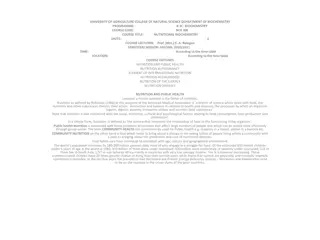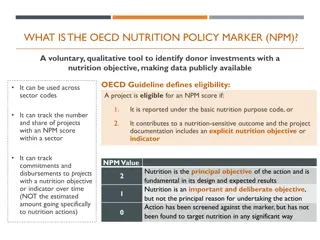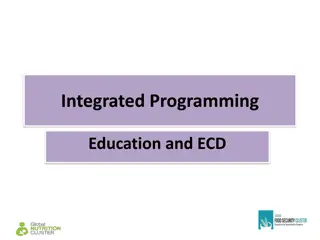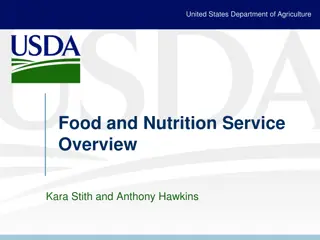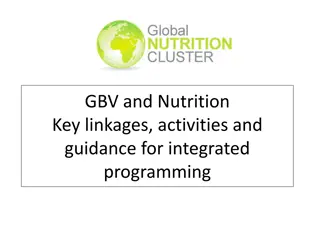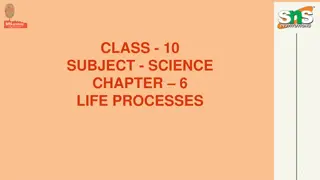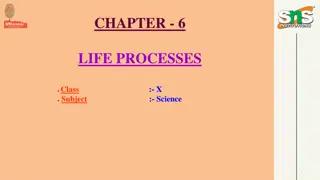Healthy Nutrition Guidelines Throughout Life
Understand the importance of nutrition at different stages of life, ranging from childhood to adolescence to adulthood. Learn about making healthy food choices, building a balanced plate, watching your calorie intake, and being physically active. Children and adolescents have unique nutritional needs that support growth and development. Discover practical tips to implement a nutritious diet tailored to your age, gender, and lifestyle.
Download Presentation

Please find below an Image/Link to download the presentation.
The content on the website is provided AS IS for your information and personal use only. It may not be sold, licensed, or shared on other websites without obtaining consent from the author.If you encounter any issues during the download, it is possible that the publisher has removed the file from their server.
You are allowed to download the files provided on this website for personal or commercial use, subject to the condition that they are used lawfully. All files are the property of their respective owners.
The content on the website is provided AS IS for your information and personal use only. It may not be sold, licensed, or shared on other websites without obtaining consent from the author.
E N D
Presentation Transcript
Nutritional Needs Throughout Life Nutritional needs throughout your life are based on: MyPlate recommendations Dietary Guideline recommendations Age Gender Activity Level
Build a Healthy Plate Make half your plate fruits and vegetables. Switch to skim or 1% milk. Make at least half your grains whole. Vary your protein food choices. Keep your food safe to eat.
Watch What You Eat Choose foods and drinks with little or no added sugars. Look out for salt (sodium) in foods you buy. Eat fewer foods that are high in solid fats. Eat the right amount of calories for you. Enjoy your food, but eat less.
Watch What You Eat Cook more often at home Choose lower calorie menu options Keep track of what you are eating by writing it down If you drink alcoholic beverages, limit it to: One drink a day for women Two drinks a day for men
Be Physically Active Your Way Pick activities that you like Start by doing what you can, at least 10 minutes at a time The more active you are, the healthier you will be
Children Age range: 12 months to 11 years Young children are active and growing Nutrient dense foods in small amounts often 1 Tbsp of food for each year of the child s life Set the example, children watch and learn from you
Children Make meals fun. Serve foods with: Bright color Different texture Different shapes Introducing new foods: One at a time At the beginning of the meal, when they are most hungry
Children Don t use food as a reward or punishment Drink water instead of sugary drinks
Adolescence Age range: 12 years to 20 years This is the second most rapid growth period of life. An increase need for almost all nutrients especially iron and calcium During growth spurts, allow for extra amounts of nutritious foods.
Adolescence Avoid high sugar and high fat snack foods. Drink water instead of sugary, caffeine and carbonated drinks.
Adult Age range: 21 years to 60 years Need the same amount of nutrition, but fewer calories. Choose a variety of healthful, low-calorie foods. Make regular physical activity a priority.
Elderly Age range: 60 years and older Good nutrition plays a major role in: Wellness Disease prevention Staying active and energetic Calorie needs drop and nutrition needs rise Eat nutrient dense foods
Elderly Need more of calcium, vitamin D and B12 Thirst signals decline with age Drink 8 cups of water or milk each day Eat more foods like soups, smoothies and cooked cereals
Elderly Special diets such as low fat or low sodium Malnutrition is a concern especially for elderly that live alone Nutritional meals are available through social service programs in the community
Sports Nutrition Guidelines For those of you who play sports or have an active lifestyle, here are some nutritional tips that should be followed.
Training Conditioning and nutrition is the key to top athletic performance. Daily food choices can make a difference between a good performance and a poor one. No need for sports bars or dietary supplements if you: Eat a variety of nutrient dense foods Follow the dietary guidelines
Training Athletes need to get: 55-60% of their calories from carbohydrates 20-25% of their calories from fat 15-20% of their calories from protein
Pre-Event/Exercise The last meal before a competition or intense exercise should be: Complex carbohydrate-rich meal Examples: Grains, fruit, starchy veggies, milk and yogurt 2-4 hours before training or competition
Pre-Event/Exercise If you have a sensitive stomach, consume the last meal: 4 hours before the event Sip on a sport drink or easily digestible carbohydrate-filled snack in the hour prior to the event
Pre-Event/Exercise The last meal before a competition or intense exercise should: Include a moderate amount of protein Low in fat Low fiber rich foods
Hydration Water helps the body regulate many important functions: Temperature Blood pressure Nutrient concentration Appropriate levels of electrolytes Nutrient transportation Recovery from intense training
Hydration Allowing the body to become dehydrated can cause: Muscles to cramp Alter blood pressure Cause weight loss during exercise Delay recovery time Decrease performance
Hydration Drinking too much water can alter electrolytes and cause bodily harm. Drink water before and after an event, even if you don t feel thirsty Drink water about every 15 minutes during an event.
Hydration Consider a sport drink for workouts over 45 minutes or workouts in the heat. Replenish 150% of lost fluid after training or an event Monitor urine color Pale yellow is ideal
During an Event/Exercise Carbohydrates are the body s primary energy source during exercise. Dietary carbohydrates (grains, fruit, starchy veggies, milk and yogurts) are stored in the liver and in the muscles as glycogen. During exercise, the body draws upon these glycogen stores (primarily muscle glycogen) to fuel working muscles.
During an Event/Exercise Having carbohydrates in your body while exercising can help improve performance by: Reducing the risk of hypoglycemia (low blood sugar) Providing fuel for actively working muscles Prevent hitting the wall and being forced to slow down or stop
During an Event/Exercise Use protein and fats sparingly You don t want your body to start breaking down muscle for energy.
Recovery The body is primed to replenish lost nutrients soon after exercise. After an event or exercise, start refueling within 15-60 minutes. Recovery has three stages Stage 1: Snack + Fluid Within 15-60 minutes Carbohydrates and 10-15 grams of protein
Recovery Stage 2: Meal + Fluid Within 2 hours Balance of carbohydrates, lean protein and low fats Stage 3: Snack + Fluid Within 4 hours Carbohydrates and 10-15 grams of protein
Summary Nutritional needs change throughout your life. Be sure to have adequate calories based on your age, gender and activity level. Be aware of the guidelines for proper sports nutrition.






